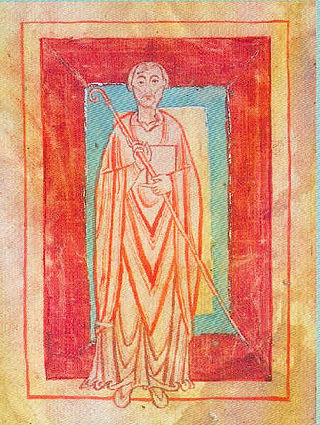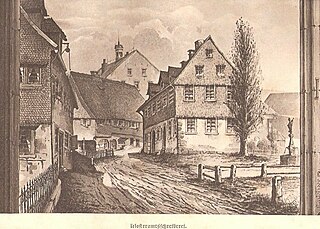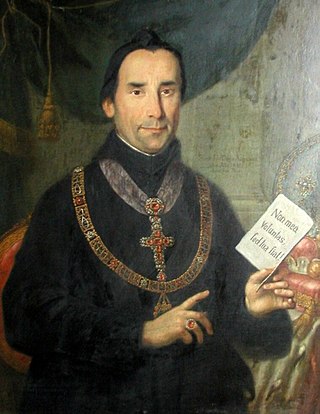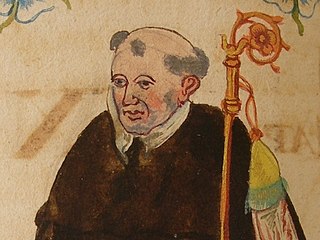Related Research Articles

The Abbey of Saint Gall is a dissolved abbey (747–1805) in a Catholic religious complex in the city of St. Gallen in Switzerland. The Carolingian-era monastery existed from 719, founded by Saint Othmar on the spot where Saint Gall had erected his hermitage. It became an independent principality between 9th and 13th centuries, and was for many centuries one of the chief Benedictine abbeys in Europe. The library of the Abbey is one of the oldest monastic libraries in the world.

William of Hirsau was a Benedictine abbot and monastic reformer. He was abbot of Hirsau Abbey, for whom he created the Constitutiones Hirsaugienses, based on the uses of Cluny, and was the father of the Hirsau Reforms, which influenced many Benedictine monasteries in Germany. He supported the papacy in the Investiture Controversy. In the Roman Catholic Church, he is a Blessed, the second of three steps toward recognition as a saint.

Ulrich of Zell, also known as Wulderic, sometimes of Cluny or of Regensburg, was a Cluniac reformer of Germany, abbot, founder and saint.

St Peter's Abbey in the Black Forest or St. Peter's Abbey, Schwarzwald is a former Benedictine monastery in the village of St. Peter im Schwarzwald, in the district of Breisgau-Hochschwarzwald, Baden-Württemberg, Germany.

St. George's Abbey in the Black Forest was a Benedictine monastery in St. Georgen im Schwarzwald in the southern Black Forest in Baden-Württemberg, Germany.

Gengenbach Abbey was a Benedictine monastery in Gengenbach in the district of Ortenau, Baden-Württemberg, Germany. It was an Imperial Abbey from the late Carolingian period to 1803.

St. Trudpert's Abbey is a former Benedictine monastery in Münstertal in the southern Black Forest, Baden-Württemberg, Germany, now the principal house of the Sisters of St. Joseph of St. Trudpert.

St. John's Abbey in the Thurtal was a Benedictine monastery originally established in Alt St. Johann in the Canton of St. Gallen, Switzerland, in the mid-12th century.

Rüti Monastery was a former Premonstratensian monastery, founded in 1206 and suppressed in 1525 on occasion of the Reformation in Zürich, situated in the municipality of Rüti in the canton of Zürich, Switzerland. The monastery's church was the final resting place of the Counts of Toggenburg, among them Count Friedrich VII and 13 other members of the Toggenburg family, and other noble families. Between 1206 and 1525, the monastery comprised 14 incorporated churches and the owner of extensive lands and estates at 185 localities.

Pankraz Vorster was a Swiss abbot. He served as the last abbot of the Abbey of Saint Gall, from 1796 to 1805.
John II was the abbot of Saint Gall and of Reichenau and, from 760 to 782, was the Bishop of Constance.

Gozbert was abbot of the Abbey of Saint Gall from 816 until 837 and also abbot of Rheinau Abbey until 850. The beginning of his term of office in Rheinau is unknown.
Werdo was abbot of the Abbey of Saint Gall in St. Gallen.
Walter von Trauchburg was abbot of the abbey of Saint Gall from 1239 until 1244. He is descended from an Allgäu noble family. His mother was a born as a von Güttingen.
Kaspar von Breitenlandenberg was prince abbot of the Abbey of Saint Gall from 1442 to 1463. He descended from a noble family from the Canton of Thurgau. His father was Rudolf V von Breitenlandenberg (Landenberg).
Kilian Germann was prince abbot of the Abbey of Saint Gall from 1529 to 1530.
Rumo von Ramstein was abbot of the Abbey of Saint Gall from 1274 until 1281.

Wilhelm I Count of Montfort was prince-abbot of Saint Gall from 1281 until 1301.
Heinrich von Wartenberg was anti-abbot of the Abbey of Saint Gall from 1272 until 1274.
References
- ↑ H. Harter: Adel und Burgen im oberen Kinziggebiet. Studien zur Besiedlung und hochmittelalterlichen Herrschaftsbildung im mittelalterlichen Schwarzwald. (= FOLG 37), Freiburg i.Br.-München 1992.
- 1 2 Berchtold von Falkenstein, in: Helvetia Sacra III/1/2 (1986), pp. 1301–1303.
- 1 2 3 4 5 6 M. Buhlmann: Das Kloster St. Georgen im Schwarzwald und die Herren von Falkenstein. in: Vertex Alemanniae. H. 26, St. Georgen 2007.
- ↑ Berchtold von Falkenstein, in: Helvetia Sacra III/1/2 (1986), pp. 1136-1137.
- ↑ Albrecht von Ramstein, in: Helvetia Sacra III/1/2 (1986), pp. 1082–1083.
- 1 2 3 Henggeler, P. Rudolf (1929). Professbuch der fürstl. Benediktinerabtei der heiligen Gallus und Otmar zu St. Gallen. Zug. pp. 106–111.
{{cite book}}: CS1 maint: location missing publisher (link)